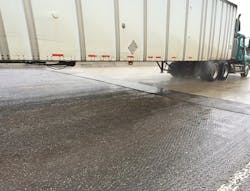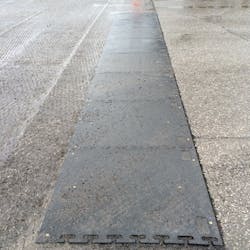Contractor uses rubber safety ramps for new pavement in Illinois
Like most DOTs, the Illinois DOT (IDOT) absolutely requires that traffic exposed to new pavement edges, like end-of-day joints and butt joints, must be protected by some form of temporary safety ramp that creates a smooth transition from the new paving surface to the original (or milled) surface. And contractors are happy to comply; preserving newly paved edges makes it much easier to match new paving when paving crews resume work, and makes for a much higher quality finished roadway.
But installing temporary safety ramps has also been, for most of roadway construction history, an exceedingly tedious task. “Here in Illinois, you need a foot of ramp for every 0.5 in. of drop—so, for example, if you’re protecting a 1.5-in. end-of-day edge, you need 3 ft of evenly sloped ramp,” explained Scott Getz, project manager at United Contractors Midwest (UCM), one of the largest pavement contractors in the Midwest.
Up until 2010, like virtually all contractors, UCM installed safety ramps by first spreading sand on the area to be ramped, then laying felt paper, and then shoveling on hot or cold mix asphalt and smoothing and tapering it by hand. “We had to have a two- or three-man crew with a truck standing by, and they all had to do a lot of shoveling and raking and compacting,” said Getz. “Later, all that material had to be picked up and scraped off, usually with a backhoe and picks. And then, because the mix is a petroleum product and you don’t want to waste it, we had to haul it all off to be dumped properly or to hopefully recycle it. All in all, the hot or cold mix ramps took several hours of labor and couldn’t really be called sustainable.”
So what changed in 2010? “One of our employees discovered a better safety ramp solution and brought it to our attention,” Getz says. “We could see the potential so we used some, on a trial basis at first, and now it’s the only method we use.”
That “better solution” was the American Highway Products Safety Ramp, distributed in Illinois by E Z Road Inc. These are tapered, interlocking segments made of 100% recycled rubber that meet state requirements as an alternative to temporary bituminous ramps, and they provide a smooth transition from 1.5-in. new paving edges down to 0.25 in. over 42 in. When transitioning from 2-in. edges, the thick edge can be shimmed up with 0.5-in. belting and still meet DOT requirements over 42 in.
“They’re all made the same and are very consistent, so we always get a perfect, even taper,” Getz said. “When using the hot or cold mix ramps, we could see humps or dips develop sometimes, especially after exposure to traffic. Since safety is the biggest thing for us, this is important.”
For UCM, installation of the AHP safety ramps is as simple as laying down rubber ramp sections and interlocking them like puzzle pieces, then securing them with screws. “It only takes a two-man crew to get them laid down and screwed tight in a few minutes,” said Getz. “The labor savings compared to the old method is tremendous—there’s just no comparison. As our workforce ages out, working more efficiently with lighter materials is really advantageous.”
As a benefit to UCM, the rubber safety ramps are indefinitely reusable. “We’re still using the first ramps we bought back in 2010,” said Getz. “And they only cost about as much as a mud flap for one of our trucks.” Given the reusability, and considering the labor and material savings during installation and removal, rubber safety ramps are a clear financial winner compared to bituminous ramps. And sustainability gains are the cherry on top.

